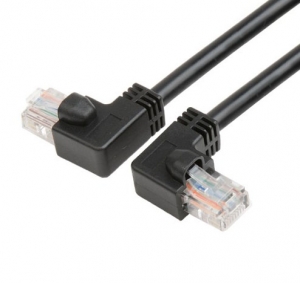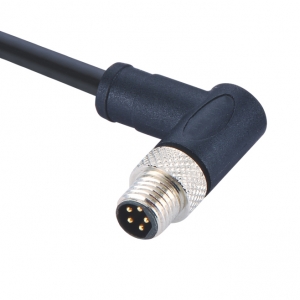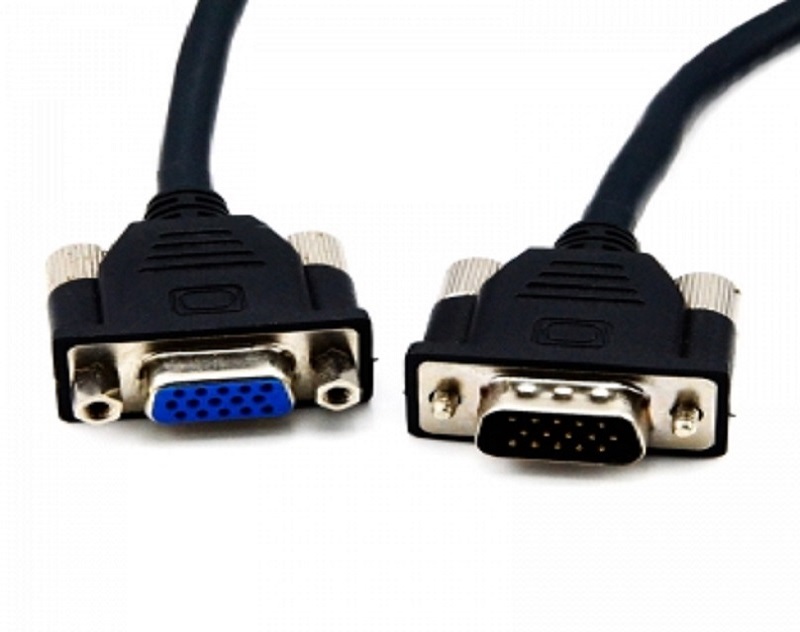-
Why Machine Vision Cables Are Imperative For Machine System?
Cable quality is an often disregarded element in enhancing the effectiveness of machine vision systems. Using inexpensive or consumer-grade mini camera link cable that are not designed to withstand industrial uses and conditions might reduce signal output including the consequent image quality in situations where excellent output is required.

Mini Camera Link Cable Because they lack the required cable shielding to prevent the signals from overlapping, subpar cables that are not made to sustain industrial use are especially susceptible to crosstalk. Read this guide to find the best machine vision cables.
Finding the Cable Quality
In order to guarantee dependability, correct data transfer, as well as longer cable lifespan, computer vision cables need to be designed to resist the rigours of industrial settings and applications. A few qualities to consider include, although aren’t limited to:
- superior outer jacket fabric
- layered shielding
- The proper reinforcing of connectors (over-molding)
A complete performance test (not a lot sampling)
As previously said, a cable that has undergone some sort of performance testing is a clear sign of quality. While near-end crossover (NeXT), far-end interference, and return loss should be tested at a minimum, there are other variables that can help you get a more full view of the cable’s performance potential.
Performance Evaluation
An issue that can happen when a connection is coupled to crossed or compressed wire pairs inside of a single link is called near-end crosstalk (NeXT). The test measures noise that occurs at the connection nearest to the source of the signal in a test setting and is expressed in decibels (dB).
Similar to NeXT, far-end crosstalk (FeXT) quantifies in dB noise that occurs at the opposite end of the signal’s origin in a testing setting.
When testing a cable, return loss is the amount of signal that is lost after travelling its whole length and back.
Attenuation is the noise component that reduces the intensity of the signal.
Connections that are angled and overmolded:
Wire breakage can be avoided by using angled cable connections with over-molding connectors.
Enhanced Durability: Low Smoky Zero Halogen (LSZH) cabling jacketing is strong enough to tolerate halogen’s high temperatures in specific defence and military applications.
Conclusion
In conclusion, these are the things to consider while buying machine vision cables. You can surely find a great cable now!
-
What Is HR10A-10P-12S Cable?
CCTV systems, sometimes referred to as video surveillance systems, are a collection of electronic devices with built-in image capturing features; Enables the compression, storage, and transmission of video pictures and other extracted data through communication networks or digital data channels. They are typically employed for environment monitoring with the aid of HR10A-7P-6S cable.

HR10A-10P-12S The numerous safety camera HR10A-10P-12S cabletypes that connect the various parts of a conventional video surveillance system will be thoroughly discussed in this topic.
Coaxial cables
Coaxial cables are large ropes of wire as well as non-metallic fibre that have an insulated inner core made of stranded and solid wire that is encircled by flexible wire braiding on the outside. Cable TV providers generally employ it to link their satellite antenna installations to client residences and places of business. The connection between central offices and phone poles close to clients is occasionally employed by telephone providers.
Twisted pair
Numerous home and business PCs are connected to the phone provider via the standard copper wire known as twisted pair.Two copper wires with insulation are wound around each other in a spiral pattern to minimise electromagnetic induction or cross-talk between pairs of wires. Twisted pair connections require both wires for each connection. Twisted pair is occasionally put in more than two pairs, all inside a single wire, as some telephones sets or desktop positions require numerous connections. Twisted pair is encased in a protective covering that serves as a ground at some commercial places.
Optical fibre
A very thin piece of pure glass called an optical fibre serves as a long-distance waveguide for light. It operates on the idea of thorough interior reflection. The real glass layers that make up fibre optic cable are the cladding, which surrounds the core, and the core, which transmits the actual light signal. The core experiences Total Internal Reflection as a result. The majority of fibres work in duplex pairs, where one fibre is utilised for transmission and the other for reception.
Conclusion
These are some of the prime types of wires that you need to for CCTV or camera connection. You can find the best wire as per your need after complete research.
-
Know The Difference Between Cat6a LAN Cable And Cat7 LAN Cables
Therefore, perhaps you’ve already read our article outlining the variations between Cat5, Cat5e, and cat7 LAN cable, Cat6 cables. If not, professionals strongly advise reading it.
This editorial will talk about the variations between Cat6 as well as Cat6a cables in this article. Although it may seem that just one lowercase letter distinguishes the two, the one small letter, which stands for “augmented,” actually denotes a vastly different situation.

Cat7 LAN Cable One of the cable standards that network technicians frequently choose is Cat6. But Cat6a outperforms its predecessor in terms of performance, crosstalk avoidance, and even size.
But is upgrading worthwhile? Know the difference between the cat6 and the cat6a LAN cables
Performance
Cat6 and cat6a LAN cable are capable of handling 10BASE-T, as well as 100BASE-TX, etc because they were both created for Gigabit Ethernet and other common network protocols. The changes are not immediately apparent unless you take into account speed and distance. When utilised for 10GBASE-T applications, Cat6 cable has a shorter maximum length (37–55 metres) due to its 250 MHz rating. By operating at greater than 500 MHz, Cat6a increases that capability and enables 10GBASE-T to be routed across larger lengths of up to 100 metres. Cat3, Cat5, along with Cat5e may all be used with Cat6 and Cat6a.
Crosstalk avoidance
Crosstalk must be mentioned because you are on the subject of performance. For those who don’t know, crosstalk is the phenomena when an electrical signal through one channel or wire interferes with a signal from another channel or circuit. It’s not what you desire. Additionally, Category 6 cable already significantly reduces signal deterioration through NEXT, voltage sum NEXT (PS-NEXT), and attenuation compared to prior versions including Cat5 and Cat5e. This is mostly due to improved insulation. This is diminished much more by Cat6a. The most notable advancement of cat6a LAN cable above Cat6 in the crosstalk space primarily relates to alien crosstalk (AXT).
Conclusion
Now that you know the difference between the Cat6 and the Cat6a LAN cable, you can find the best one as per your need.
-
Why Should You Use The M12 Female Cable For Your Ethernet Connection?
Although m12 cable connections are frequently a superior option for many applications, RJ45 plug connections are still the most common connection technology that allows Ethernet systems deployed in tough outdoor or industrial locations. Experts believe M12 connections are a better choice for the following reasons:

M12 Cable An IP67 certification
It indicates that the link is totally protected from contamination and brief submersion around 12 cm and 1 m. A m12 female cable with an IP68 classification is completely shielded from dust and prolonged submersion under pressure. These two grades are unavoidably necessary for connections used in severe industrial settings.
Compact form
Despite being built to resist harsh environments, M12 connections nonetheless have a compact form that is ideal for conserving space in often packed enclosures and cabinets.
Stable Connection
Despite their small size, M12 connectors are exceptionally sturdy and resilient and offer a secure connection even when exposed to high stress or vibration.
Two Pin Configurations
M12 Ethernet connections are available with four and eight pins, respectively. Fast Ethernet transmission works flawlessly with four-pin M12 connections that use D-coding. Higher transmission speeds, such Gigabit Ethernet, can be delivered using eight-pin M12 connections, which are often A-coded. Additionally, L-com provides Category 6a applications-compatible, 10Gbps-rated 8-pin, X-coded M12 cables.
Power over Ethernet systems can employ POE
The type-1 transmission method, in which supply, voltage, and data are all delivered simultaneously, may be utilised with the four-pin connections. Type-2 power may be delivered by eight-pin systems by using the two extra wire pairs of m12 female cable to convey the supply voltage individually.
Conclusion
These are some benefits of using the M12 cables. You must use the M12 cables for your connections and get the best speed.
-
Top Troubleshoots For Cable Assembly Problems
The words “cable assembly” and “wire harness” are frequently used interchangeably by industry experts. Although cable assembly solutions could perform similar fundamental tasks, they are unique items made for various situations, and each one needs a unique approach to troubleshooting.

Cable Assembly Solutions Cable assemblies are made up of many wires or cables by cable assembly manufacturers that are encased in an outer sheath. The sheath, on the other hand, is constructed of stronger materials like vinyl, shrink-wrapped thermoplastic, or thermoplastic rubber. Because of its tough design, it can survive harsh environmental conditions, protecting the conductors from forces that may harm them, like as abrasion, enlargement, friction, heat, and moisture.
Common issues with wire harnesses and cable assemblies
Cable assembly including wire harnesses may have issues that impair their functionality. To avoid future costly repair or replacement concerns, it is crucial to develop a knowledge about these kinds of problems, including the reasons for them, what symptoms they display, and how to avoid/resolve them.
Typical Cable Assembly Problems
The following are a few of the most typical issues with cable assemblies:
Cable selection
Selection of the wrong cables for a cable assemblage should take into account the application as well as environment. Otherwise, they can operate poorly, poorly, or fail altogether. For instance, in the application and environment specified, the cables and wires must be strong enough to sustain a sufficient level of stress. They could break or lose connection if the connections are too weak. An assembly’s strength can be determined and/or verified using a pull test.
Installation errors
It is important to install the wiring, cables, and various other assembly parts correctly. Incorrect installation might result in damage that degrades their performance. For instance, if the technician places the die wrongly, unbalanced pressure may result, which might create a subpar crimp and eventual degradation. The technician risks leaving build up behind if they solder the cable assembly solutions haphazardly, which might affect connections?
Conclusion
These are a few ways to troubleshoot the Cable assembly issues. You should always find the best cable assembly solution to avoid these issues.
-
What Is SCSI Cable?
The Small Computer System Interface (SCSI) cable is a type of high-speed data transfer cable that is used to connect various types of peripherals to a computer. It was first developed in the 1980s and was widely used in the 1990s before being replaced by newer interfaces like USB and FireWire.

SCSI cables SCSI cables are available in various types, including SCSI-1, SCSI-2, SCSI-3, and Ultra SCSI. They typically consist of a 50 or 68-pin connector on one end and a Centronics or DB25 connector on the other end. The cable itself is shielded to reduce interference and improve signal quality.
SCSI cables are used to connect a wide variety of devices, including hard drives, tape drives, scanners, and printers. They provide high-speed data transfer rates and support multiple devices on the same cable, which makes them useful for connecting multiple peripherals to a single computer.
Despite being largely replaced by newer interfaces, SCSI cables are still used in some specialized applications, such as in the audio and video production industry. Overall, SCSI cables played an important role in the development of computer peripherals and continue to be used in certain niche applications.
What is MDR Cable?
MDR (Micro-D Ribbon) cable is a type of cable used in a variety of industries, including aerospace, military, and medical. It is designed to be small, lightweight, and high-performance, making it ideal for applications where space is limited or weight is a concern.
MDR cables consist of a flat ribbon cable with multiple conductors that are surrounded by a protective jacket. They are available in a range of sizes, from 9 to 100 pins, and can be shielded or unshielded depending on the application requirements. MDR cables are typically terminated with a Micro-D connector, which is a small, rectangular connector with pins arranged in a row.
One of the advantages of MDR cables is their high-density packaging. They allow for a large number of conductors to be packed into a small space, which is important in applications such as aerospace and medical where weight and space are critical. MDR cables also provide reliable signal transmission and low crosstalk, making them ideal for applications that require high-speed data transfer.
Overall, MDR cables are a high-performance, reliable, and versatile cable option that is ideal for applications that require high-density packaging and high-speed data transfer. Their small size, lightweight design, and robust construction make them a popular choice in industries where weight and space are at a premium.
-
M12 Cables: Understanding Their Applications And Advantages
M12 cables are a type of circular connector widely used in industrial and automation applications. These cables have a 12mm locking thread, and come in male or female configurations. The M12 interface is designed to provide a reliable and robust connection in harsh environments, where vibration, moisture, and dust can damage more fragile connections.

M12 Cables M12 cables are commonly used in applications that require high-speed data transmission, such as in Ethernet networks or Fieldbus systems. They can also be used in sensors, actuators, and other devices that require a compact and secure connection. M12 cables come in various types, including shielded or unshielded, and with different numbers of pins, depending on the specific application requirements.
One of the main advantages of M12 cables is their durability and resistance to harsh environmental conditions. They can also be quickly and easily installed, reducing downtime and maintenance costs. Additionally, M12 cables are compatible with a wide range of devices, making them a versatile and cost-effective solution for many industrial and automation applications.
When it comes to choosing the right M12 female cable for your industrial networking needs, there are several factors to consider. The first thing to determine is the specific application requirements, such as data transfer rate, distance, and environment. It is important to choose a cable that is appropriate for the application and can withstand any environmental hazards that may be present.
Another important factor to consider is the number of pins needed for the specific application. M12 cables come in various pin configurations, so it is important to choose a cable that matches the requirements of the device. Additionally, the length of the cable may need to be considered, depending on the distance between devices.
Choosing the right M12 female cable can help ensure reliable and efficient networking in industrial settings. Taking the time to assess the specific needs of the application and selecting the appropriate cable can ultimately lead to improved productivity and profitability.
-
HR10A-10P-12S Cable: An Overview Of Features And Applications
When it comes to choosing between HR10A-10P-12S and HR10A-7P-6S cables, the decision ultimately depends on your specific application requirements. Both cables are designed for use in harsh environments, including outdoor and industrial settings, and offer reliable connectivity for a range of applications. However, there are some key differences between the two cables that you should consider before making a decision.

HR10A-10P-12S Cable The HR10A-10P-12S cable features 10 pins and 12 sockets, making it ideal for transmitting a high number of signals in a single cable. This cable is commonly used in industrial automation and robotics applications, where precise control and communication between components is crucial. The cable is also designed to withstand harsh environments, with a waterproof and dust proof construction that can withstand exposure to extreme temperatures and humidity.
In contrast, the HR10A-7P-6S cable features 7 pins and 6 sockets, making it a more compact and lightweight option for applications where space is limited. This cable is commonly used in medical equipment and imaging devices, where reliable signal transmission is critical for accurate diagnosis and treatment. The cable is also designed to withstand exposure to chemicals and radiation, making it ideal for use in medical environments.
When choosing between HR10A-10P-12S and HR10A-7P-6S cables, it’s important to consider the specific requirements of your application. If you need to transmit a large number of signals in a harsh environment, the HR10A-10P-12S cable may be the best choice for your needs. If you require a more compact and lightweight option for medical or imaging equipment, the HR10A-7P-6S cable may be the better choice.
It’s also worth considering the cost and availability of each cable. The HR10A-10P-12S cable may be more expensive due to its higher pin and socket count, while the HR10A-7P-6S cable may be more widely available and easier to source.
Ultimately, the choice between HR10A-10P-12S and HR10A-7P-6S cables comes down to your specific application requirements and budget. By carefully considering your needs and researching your options, you can select the cable that best meets your needs for reliable and high-quality connectivity in harsh environments.
-
Maximizing Your Home Theater: The Benefits Of HDMI Extension Cables
HDMI extension cables are a great way to get the most out of your home theater setup. They allow you to extend the reach of your HDMI cable, giving you more flexibility in where you can place your devices. This is particularly useful if you have a large room or if your TV is mounted on the wall. HDMI extension cables also ensure that your signal remains strong and reliable, preventing any signal loss or interference. With the right extension cable, you can enjoy high-quality audio and video from any device without compromising on image or sound quality. Whether you’re watching movies, playing games, or streaming your favourite shows, HDMI extension cables can help you create the ultimate home theater experience.

HDMI Extension Cables HDMI (High-Definition Multimedia Interface) 2.1 is the latest version of the HDMI cable technology. Compared to its earlier versions, HDMI 2.1 boasts higher bandwidth, allowing for higher resolutions and faster refresh rates. It also supports dynamic HDR (High Dynamic Range) for more accurate and vivid colors, as well as eARC (Enhanced Audio Return Channel) for improved audio quality.
For gamers, HDMI 2.1 also includes Variable Refresh Rate (VRR) and Auto Low Latency Mode (ALLM), which reduces lag and input delay.
However, it’s important to note that not all devices and TVs support HDMI 2.1 yet, so it’s essential to check compatibility before purchasing. HDMI 2.1 cables are also typically more expensive than earlier versions, so it’s important to weigh the benefits against the cost.
-
Cat6a vs. Cat7 LAN Cables: Which One Should You Choose For Your Network
Choosing the right LAN cable for your business network is crucial for ensuring reliable and high-speed data transmission. Two popular options are Cat6a and Cat7 cables, each with their own unique features and benefits. Here’s a guide to help you choose the right one for your business network needs.

Cat6a LAN cables Cat6a LAN cables are a step up from Cat6 cables, offering higher data transmission speeds of up to 10 Gbps and a frequency range of up to 500 MHz. They are also shielded, which provides better protection against electromagnetic interference (EMI) and crosstalk. This makes them a great option for businesses that require high-speed data transmission for streaming, cloud computing, and other data-intensive applications.
Cat7 LAN cables, on the other hand, offer even higher data transmission speeds of up to 40 Gbps and a frequency range of up to 600 MHz. They are also shielded, but with additional shielding layers, which makes them more resistant to EMI and crosstalk. This makes them ideal for businesses that require ultra-high-speed data transmission for applications like virtual reality, gaming, and 4K video streaming.
When choosing between Cat6a and Cat7 LAN cables, it’s essential to consider your business network’s specific needs. If you need high-speed data transmission and can benefit from speeds of up to 10 Gbps, Cat6a cables may be the best option for you. If your business requires even higher data transmission speeds of up to 40 Gbps, Cat7 cables are the way to go.
Another factor to consider is the length of the cable runs. Cat7 LAN cables are thicker and more rigid than Cat6a cables, which can make them more challenging to install and bend around corners. They are also less widely available and more expensive. If your network has short cable runs and doesn’t require ultra-high-speed data transmission, Cat6a cables may be the more practical option.
In conclusion, choosing the right LAN cable for your business network is a critical decision that can affect your network’s performance and reliability. By considering the data transmission speeds, frequency range, shielding, and cable runs, you can choose the right Cat6a or Cat7 LAN cable for your business network needs.
